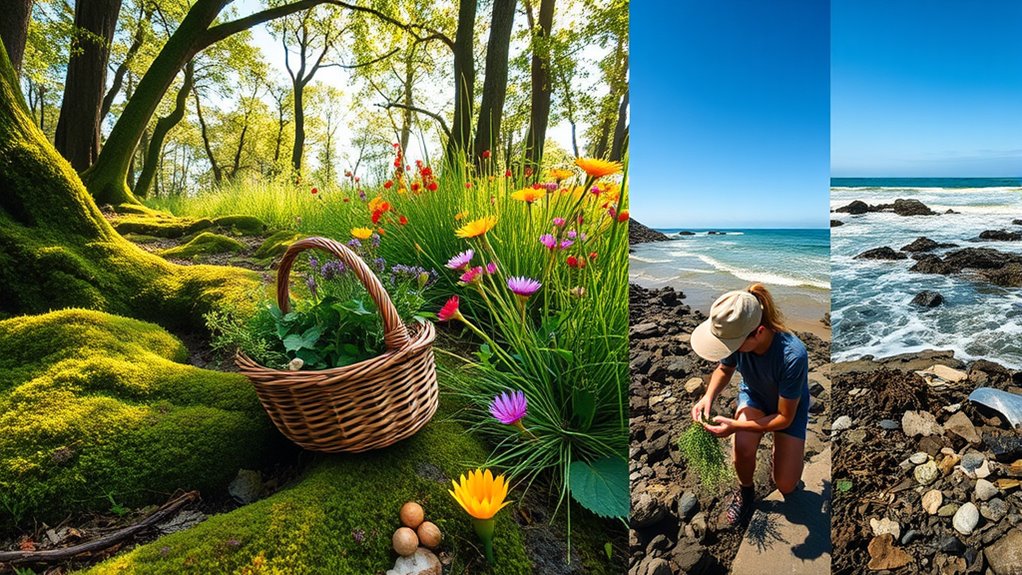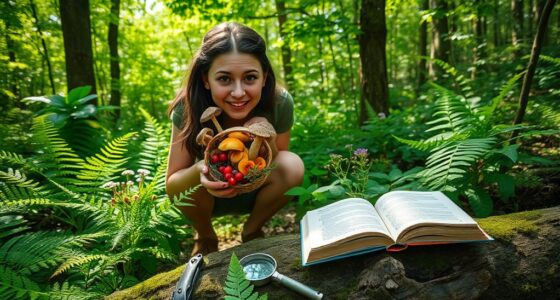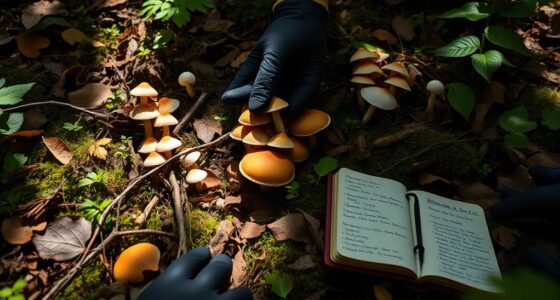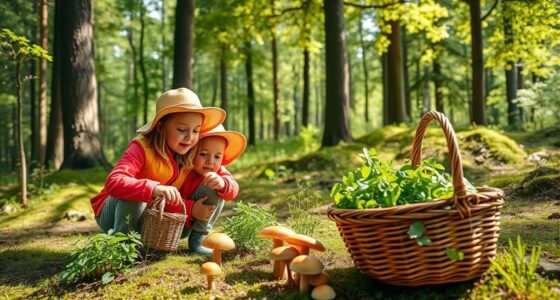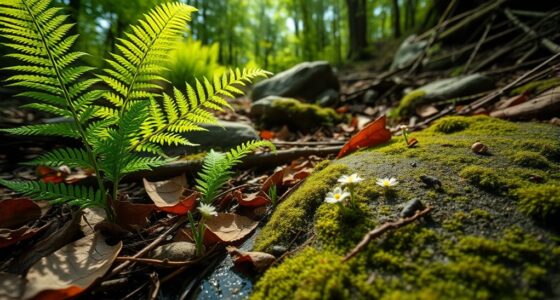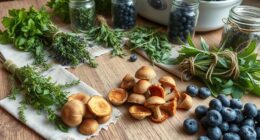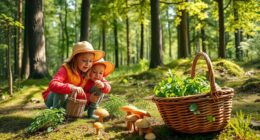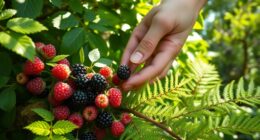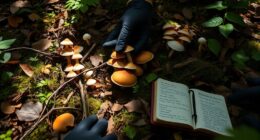When foraging in forests, meadows, and beaches, you’ll find diverse edible plants and fungi suited to each environment. In forests, look for shaded area plants like ferns or roots in clearings, but stay cautious and use guides. Meadows offer quick-harvest greens and herbs, while beaches reveal seaweeds and fungi. Carry sharp tools, protective gear, and know regulations to forage responsibly. Keep exploring, and you’ll uncover the secrets behind sustainable foraging across these terrains.
Key Takeaways
- Identify edible plants specific to forests, meadows, and beaches while respecting local regulations and environmental health.
- Use appropriate tools like knives, baskets, and guides for safe and efficient harvesting in diverse terrains.
- Practice sustainable foraging by only collecting from healthy populations and avoiding rare or endangered species.
- Be cautious of toxic look-alikes, handle plants carefully, and wear protective gear to ensure safety in all environments.
- Respect ecosystem habitats, minimize disturbance, and follow rules to promote conservation across forests, meadows, and coastal areas.
Foraging in Forest Environments
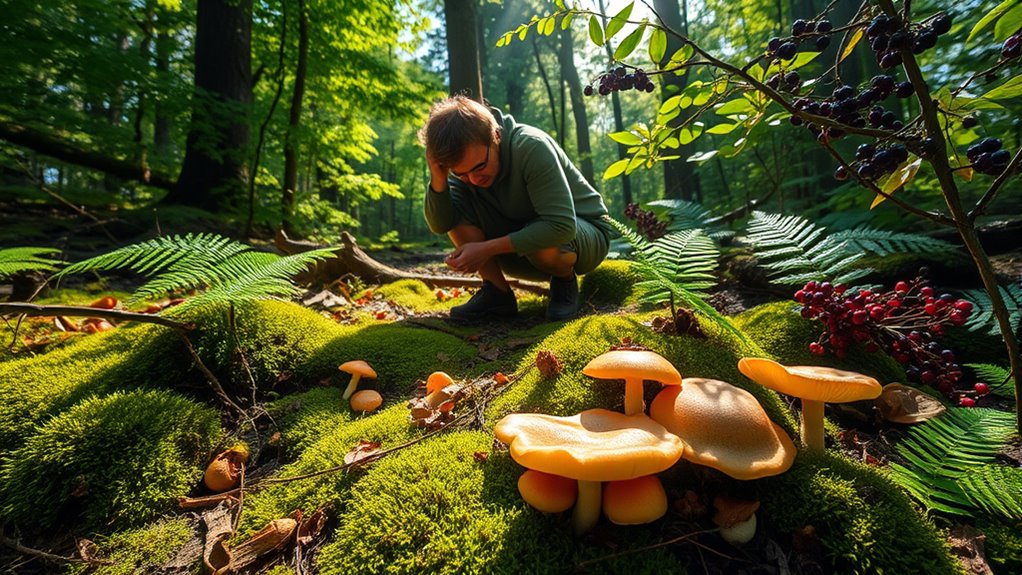
Foraging in forest environments offers a rich variety of edible plants, but it requires attentiveness to the unique terrain features. As you explore, you’ll notice how sunlight and moisture levels shape plant growth. Shaded areas under tree canopies often host ferns and other shade-tolerant species, while clearings may yield dandelions and elderberries.
Rich soils, enriched by leaf litter and roots, support numerous edible plants like wild garlic and ramps. Forest edges provide a changeover zone with diverse plant life, including chickweed and stinging nettles—though the latter needs careful handling due to its sting.
High moisture levels support plants suited for damp conditions. Always stay cautious, wear protective clothing, and use identification guides to guarantee safe harvesting, respecting the ecosystem’s balance.
Exploring Edible Plants in Meadows
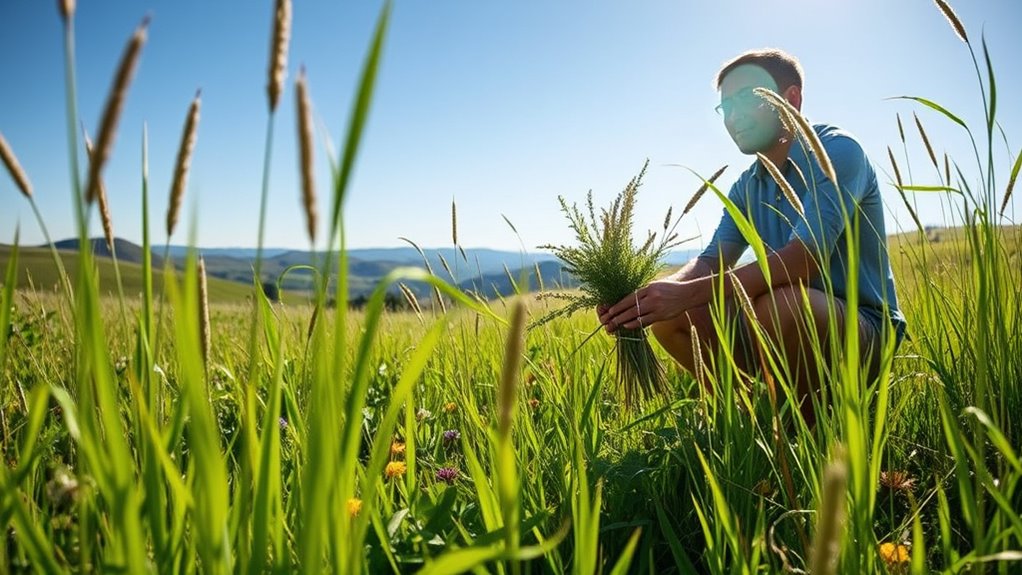
Meadows offer a vibrant and diverse environment for discovering edible plants, combining beauty with practicality. Here, you’ll find a mix of perennial plants like dill, chrysanthemum greens, and perennial rocket, providing sustainable options for the long term. Proper identification is vital, as some edible plants can be confused with toxic look-alikes, so carrying a plant identification guide can be very helpful. Consulting a wild edible plant resource can enhance your foraging success and safety. Annual vegetables such as turnips and radishes offer quick, early harvests, making meadows a versatile foraging spot. Common edible plants include camas, silverweed, dandelion, red clover, and goatsbeard, each adding nutritional variety to your diet. Foraging in meadows supports local biodiversity and promotes eco-friendly practices. Being aware of plant toxicity and potential environmental contaminants is essential to ensure safe consumption. However, accurate plant identification is essential to avoid poisoning. Be mindful of seasonal changes and land access restrictions. With proper knowledge and sustainable practices, meadows become a valuable resource for nourishing yourself and supporting ecosystem health.
Discovering Coastal Fungi and Seaweeds
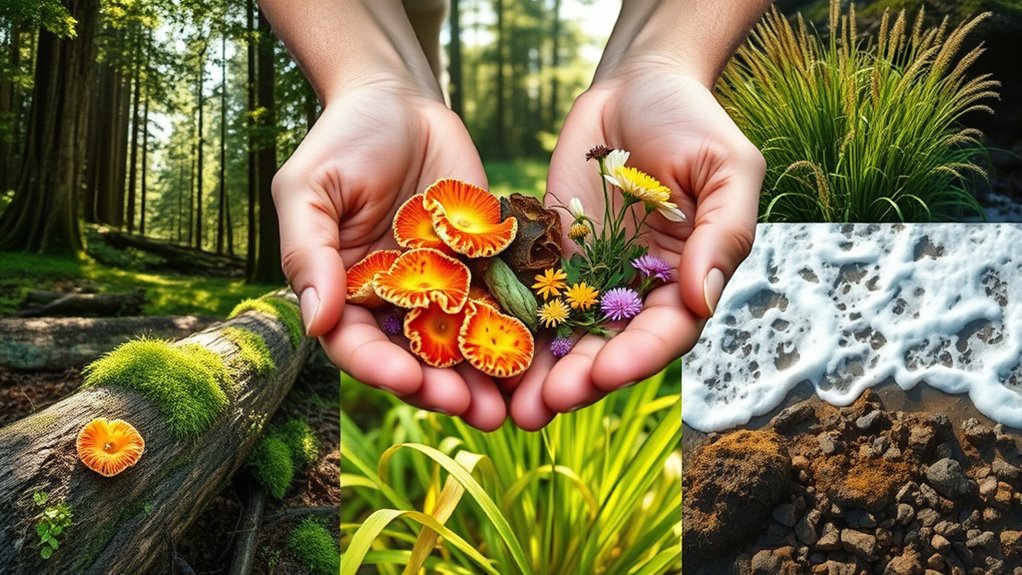
Coastal environments host a fascinating diversity of fungi and seaweeds that are valuable for both nutrition and ecosystem health. Marine fungi, with over 2,100 species, adapt to salty waters and often grow on decaying wood or marine substrates. They play a crucial role in breaking down organic matter and cycling nutrients, supporting coastal ecosystems. Tableware is often used to serve and display these foraged foods during meals. Identifying these fungi involves examining spore color, shapes, sizes, and habitat clues—yet many look alike, so expert consultation is wise. Understanding fungi identification can help prevent the collection of toxic species and promote sustainable foraging. Seaweeds, meanwhile, offer a wide range of edible and medicinal options, providing essential nutrients and forming habitats for marine life. They also help protect coastlines. As you forage, remember to be cautious of toxic species, follow sustainable practices, and respect local regulations to preserve these essential coastal resources.
Essential Tools for Safe and Effective Foraging
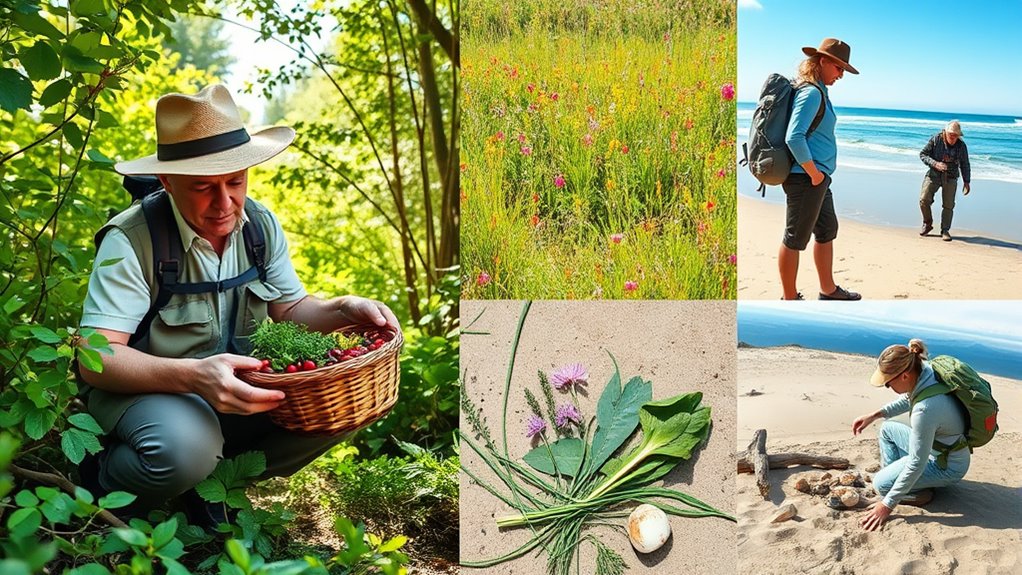
Having the right tools can make your foraging experience safer and more successful. A sharp fixed-blade knife is essential for sturdy tasks like cutting branches or harvesting tough plants.
Equipping yourself with the right tools ensures safer, more successful foraging adventures.
Binoculars help you scout for foraging spots from a distance, saving time and energy. Top-rated tools can significantly improve your efficiency and safety during foraging trips.
Hori-hori knives are versatile for digging and cutting, while digging forks allow you to extract roots carefully without damage.
Gloves protect your hands from thorns, prickles, and irritants.
For meadow foraging, baskets or bags are crucial for collecting items, and scissors assist in harvesting herbs and flowers.
A field guide boosts your plant identification skills and enhances your knowledge of local flora. Understanding wild plant identification is essential for safe foraging and avoiding poisonous species. Additionally, learning about foraging safety tips can help prevent accidents and ensure sustainable harvesting.
In coastal areas, waders or hip boots give you access, and seaweed rakes help gather marine plants.
Always carry insect repellent and a first aid kit for added safety.
Practicing Responsible and Sustainable Harvesting
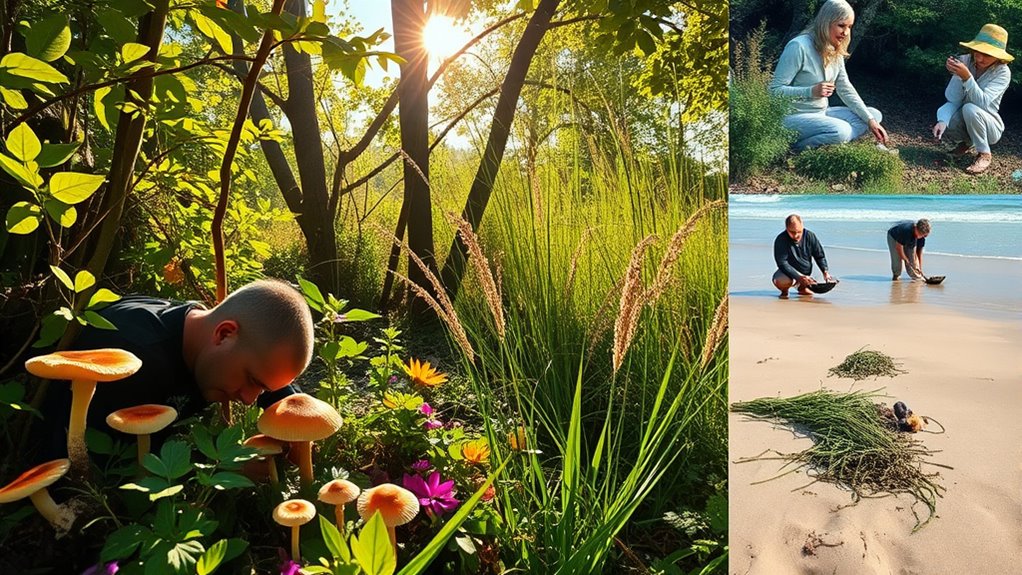
Practicing responsible and sustainable harvesting is essential to guarantee that foraging benefits both you and the environment. You should only take from large, healthy populations to prevent over-depletion and avoid rare woodland medicinals, favoring common weeds instead.
Always assess local demand and plant health to avoid damaging reproductive success. Check regulations and get permissions when foraging in protected areas. Incorporating a monitoring of environmental health can help you adapt your foraging practices as you learn more about sustainable methods and environmental impacts. Paying attention to plant nutrient content can also guide responsible harvesting by ensuring you do not deplete vital resources unnecessarily. Maintaining proper portioning and storage of harvested foods helps prevent waste and supports ongoing sustainability. Additionally, understanding native versus invasive species can aid in making environmentally conscious choices that benefit the local ecosystem.
In meadows, harvest no more than 20% of abundant, non-native plants, and avoid disrupting wildlife or natural cycles.
On beaches, follow local rules, identify plants correctly, and avoid pollutants. Harvest only what’s needed, minimize habitat damage, and consider removing invasive species to support ecosystem balance.
Frequently Asked Questions
How Do I Identify Edible Plants in Unfamiliar Terrains Safely?
When you encounter unfamiliar terrains, you should start by observing plant traits closely. Avoid plants with milky sap, spines, or waxy leaves, as they often indicate toxicity.
Use field guides and consult experts to verify identifications.
Test for edibility carefully, beginning with skin contact, then taste small amounts.
Recognize your environment’s unique plants, and always err on the side of caution to guarantee your safety while foraging.
What Are Common Mistakes to Avoid During Foraging Trips?
During your foraging trips, avoid common mistakes by staying informed, respecting regulations, and practicing safety. Don’t misidentify plants, rely only on trusted resources, or consume unfamiliar species.
Respect private property and protected areas, obtain necessary permissions, and research local laws.
Follow safety guidelines, be aware of allergies, and learn about poisonous lookalikes.
Practice ethical foraging by minimizing environmental impact, avoiding over-harvesting, and respecting other foragers and ecosystems.
How Can I Tell if a Mushroom or Seaweed Is Toxic?
To tell if a mushroom or seaweed is toxic, always rely on expert identification and avoid guesses. For mushrooms, look for distinctive features and use new testing methods like amanitin detection when possible.
With seaweed, be cautious of unusual colors, textures, or odors, especially during algal blooms. When in doubt, don’t eat it.
Consulting local guides and educational resources helps make certain your foraging stays safe.
Are There Specific Seasons Best for Foraging in Each Terrain?
You want to know the best seasons for foraging in different terrains. Typically, spring is ideal for collecting greens, ramps, and early fungi.
Summer offers berries and edible flowers, while autumn is perfect for nuts and late-season greens.
Winter focuses on roots and buried fungi.
How Do Weather Conditions Affect the Availability of Edible Plants?
Weather conditions directly impact the availability of edible plants. When it’s rainy and moist, plants and fungi thrive, making foraging easier.
Hot, dry weather can reduce plant growth, while extreme temperatures disrupt growth cycles.
Storms and strong winds can damage plants, lowering their abundance.
Droughts and climate change further reduce plant availability by causing water shortages, soil salinity, and pest problems, making it harder for you to find edible plants in the wild.
Conclusion
So, now you’re practically a foraging pro—armed with knowledge, a keen eye, and maybe a little too much confidence. Just remember, not everything that looks tasty is actually your ticket to a five-star meal. Respect nature’s rules, harvest responsibly, and avoid becoming a headline. After all, the only thing you want to be known for is your impressive wild food stash, not for turning a lovely day at the beach or forest into an unexpected adventure in the ER.

